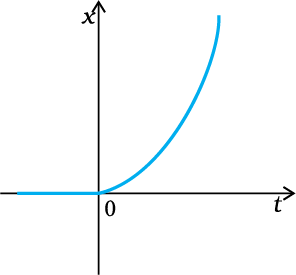The figure shows the \(x-t\) plot of the one-dimensional motion of a particle. Is it correct to say from the graph that the particle moves in a straight line for \(t<0\) and on a parabolic path for \(t>0?\) If not, suggest a suitable physical context for this graph.

| 1. | Yes, the particle moves in a straight line for \(t<0\) and on a parabolic path for \(t>0.\) |
| 2. | No, for \(t<0,\) the particle is at rest, and for \(t>0,\) it moves with uniform acceleration. |
| 3. | No, the particle moves with uniform speed for \(t<0\) and with uniform velocity for \(t>0.\) |
| 4. | Yes, the graph represents uniform acceleration for all values of \(t.\) |
No.
The x-t graph of a particle moving in a straight line for t < 0 and on a parabolic path for t > 0 cannot be shown as the given graph. This is because, the given particle does not follow the trajectory of the path followed by the particle as t = 0, x = 0. A physical situation that resembles the above graph is of a freely falling body held for some time at a height.

© 2026 GoodEd Technologies Pvt. Ltd.